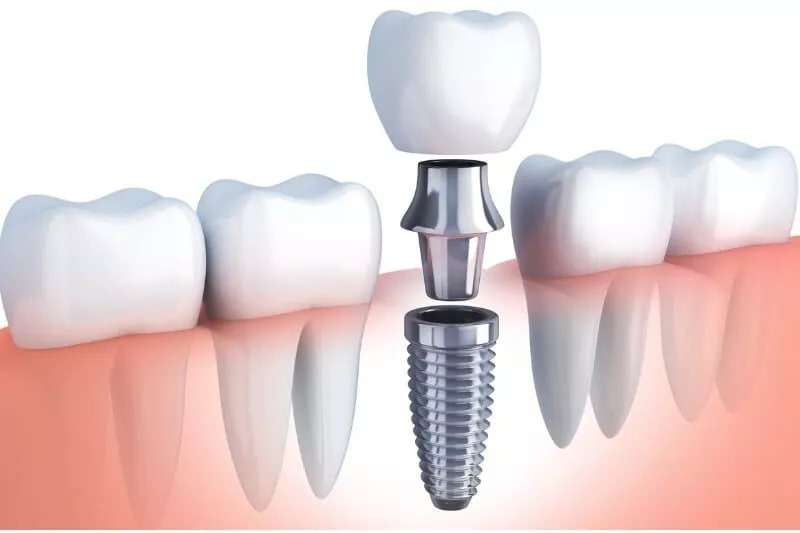Dental Implant for Single Missing Tooth: Complete Treatment Guide
 Dental Implants
Dental Implants
 Dental Implants
Dental ImplantsDental Implant for Single Missing Tooth: Complete Treatment Guide
Introduction
Losing a single tooth can affect your smile, confidence, and overall oral health. Fortunately, dental implants provide a reliable and long-lasting solution. As the gold standard for tooth replacement, implants offer a natural look and feel, preserving jawbone health while ensuring functionality. This comprehensive guide covers everything you need to know about using a dental implant to replace a single missing tooth, including the procedure, costs, benefits, and essential aftercare tips.
1. Why Choose a Dental Implant for a Single Missing Tooth?
Dental implants are widely regarded as the best option for replacing a single missing tooth due to their durability, functionality, and aesthetic appeal. They are surgically placed into the jawbone, acting as an artificial root for a custom-made crown that perfectly mimics a natural tooth.
Key Benefits of Dental Implants:
- Natural Appearance and Functionality: Dental implants look, feel, and function like natural teeth, allowing you to eat, speak, and smile confidently.
- Long-Lasting Solution: Unlike bridges or dentures that require periodic replacement, dental implants can last a lifetime with proper care.
- Preservation of Jawbone Health: Implants stimulate the jawbone, preventing bone loss and maintaining facial structure.
- No Impact on Adjacent Teeth: Unlike dental bridges, implants do not require grinding down adjacent teeth, preserving their integrity.
- Enhanced Comfort and Stability: Implants are securely anchored in the jawbone, offering superior comfort and stability compared to removable dentures.
When is a Dental Implant Recommended?
- Single Tooth Loss: Ideal for replacing a single missing tooth without affecting adjacent teeth.
- Good Oral Health: Candidates should have healthy gums and sufficient jawbone density to support the implant.
- Commitment to Oral Hygiene: Proper oral care is essential for the long-term success of dental implants.
2. The Dental Implant Procedure for Single Tooth Replacement
The process of getting a dental implant for a single missing tooth involves multiple stages to ensure a secure and natural-looking result.
Step 1: Initial Consultation and Assessment Singale Dental Implant
Singale Dental Implant
- Comprehensive Examination:
- Dental X-rays and 3D imaging are conducted to evaluate the jawbone’s density and determine the optimal implant placement.
- Your dentist will assess your oral health, including gum condition and the presence of any infections.
- Customized Treatment Plan:
- A personalized treatment plan is created, detailing the timeline, costs, and post-surgery care instructions.
- Discussion of sedation options to ensure comfort during the procedure.
Step 2: Tooth Extraction (If Necessary)
- Timing:
- If the tooth to be replaced is still present and damaged, it will be extracted.
- Healing Time: Typically, a 6-8 week healing period is required before implant placement.
- Immediate Implant Placement:
- In some cases, the implant can be placed immediately after extraction if the bone condition allows.
Step 3: Bone Grafting (If Required)
- Purpose:
- If the jawbone lacks sufficient density or volume, a bone graft may be necessary to support the implant.
- Healing Time:
- It usually takes 3-6 months for the graft to integrate with the jawbone.
Step 4: Implant Placement
- Procedure:
- Local anesthesia is administered for pain-free surgery.
- A small incision is made in the gum to expose the jawbone.
- A pilot hole is drilled, and the titanium implant post is placed securely into the jawbone.
- The gum is stitched back, and a healing cap is placed on the implant post.
- Healing and Osseointegration:
- The implant fuses with the jawbone through a process called osseointegration, which provides stability similar to natural tooth roots.
- Healing Duration: 3-6 months, depending on individual health and bone quality.
Step 5: Abutment Placement
- Description:
Dental Implant System
- Once the implant has fully integrated with the jawbone, the healing cap is removed, and an abutment is attached.
- The abutment serves as the base for the artificial crown.
- Healing Time:
- The gum tissue heals around the abutment in about 2 weeks.
Step 6: Crown Placement
- Final Step:
- A custom-made crown is designed to match the colour, shape, and size of your natural teeth.
- The crown is securely attached to the abutment using dental cement or screws.
- Result:
- A fully functional and aesthetically pleasing tooth replacement.
3. Cost of Dental Implant for Single Missing Tooth
The cost of a single dental implant varies depending on multiple factors, including location, dentist expertise, and additional procedures required.
Cost Breakdown:
- Initial Consultation and X-Rays: ₹500
- Dental Implant Cost: ₹35000 - ₹50000 for a single dental implant.
Insurance Coverage and Financing Options:
- Insurance: Some dental insurance plans cover a portion of the implant cost.
- Payment Plans: Many dental clinics offer financing options with monthly installments.
4. Aftercare and Maintenance of Dental Implants
Proper aftercare is crucial for successful healing and long-term success.
Immediate Post-Surgery Care:
- Pain Management: Use prescribed painkillers and ice packs for swelling.
- Oral Hygiene:
- Avoid brushing the implant site for the first 24 hours.
- Use saltwater rinses to keep the area clean and prevent infections.
- Dietary Restrictions:
- Stick to soft foods like yogurt, soup, and smoothies for the first week.
- Avoid hard, chewy, and hot foods that can irritate the implant site.
Long-Term Maintenance:
- Oral Hygiene Routine:
- Brush twice daily with a soft-bristled toothbrush.
- Floss carefully to prevent plaque build-up around the implant.
- Regular Dental Check-Ups:
- Visit your dentist every 6 months for check-ups and professional cleaning.
- Avoid Harmful Habits:
- Refrain from smoking, which can hinder healing and increase the risk of implant failure.
- Avoid chewing on hard objects like ice or pencils.
5. Success Rate and Potential Risks
Dental implants have a high success rate of 95-98%. However, complications can occur.
Potential Risks and Complications:
- Infection at the Implant Site
- Implant Failure due to Inadequate Bone Integration
- Nerve Damage, Leading to Numbness or Pain
- Sinus Complications (for upper jaw implants)
How to Minimize Risks:
- Choose an experienced dental surgeon.
- Follow post-surgery care instructions meticulously.
- Maintain excellent oral hygiene.
Related Articles
Multiple Dental Implants: A Complete Treatment Guide for a Healthy Smile
All-on-4 Implants Multiple Dental Implants: A Complete Treatment Guide for a Healthy Smile Introduction Tooth loss can significantly impact your oral health, confidence, and quality of life. Whether you’re missing multiple teeth due to decay, gum ...Tooth Whitening Complete Treatment Guide
TOOTH WHITENING BEFORE & AFTER Introduction A bright, white smile is often associated with confidence and good oral health. Teeth whitening is a popular cosmetic dental treatment that helps remove stains and discoloration to achieve a brighter smile. ...6 Stages of Dental Implant Treatment
6 Stages of Dental Implant Treatment: A Complete Guide to Successful Restoration Introduction Dental implants are a revolutionary solution for replacing missing teeth, offering durability, functionality, and a natural appearance. However, the journey ...Why Replacing Missing Teeth Matters |Our Free Dental Guide
The Importance of Replacing Missing Teeth & Your Treatment Options Why Should You Replace Missing Teeth? Tooth loss isn’t just a cosmetic concern—it affects your overall oral health, jaw structure, and quality of life. Missing teeth can lead to bone ...Misaligned Teeth Treatment Guide
Misaligned Teeth Treatment Guide: Learn How Ceramic Braces Work? Introduction Misaligned teeth, also known as malocclusion, can affect both aesthetics and oral health. Crooked or crowded teeth may lead to difficulty chewing, speech problems, and an ...